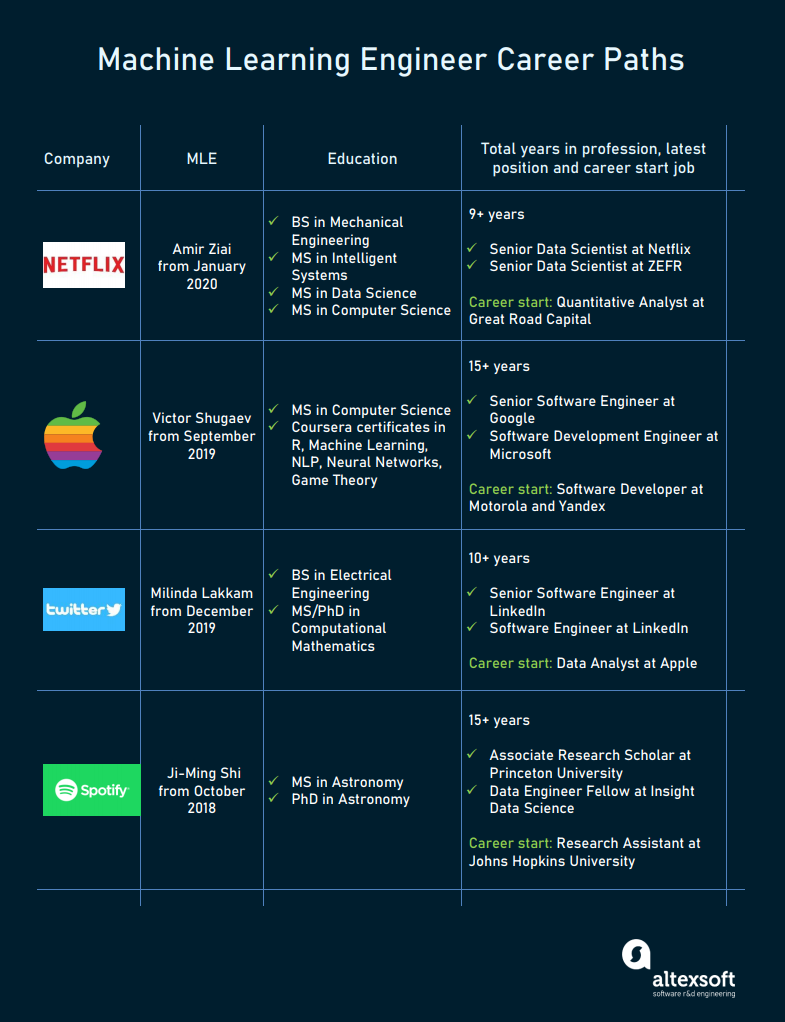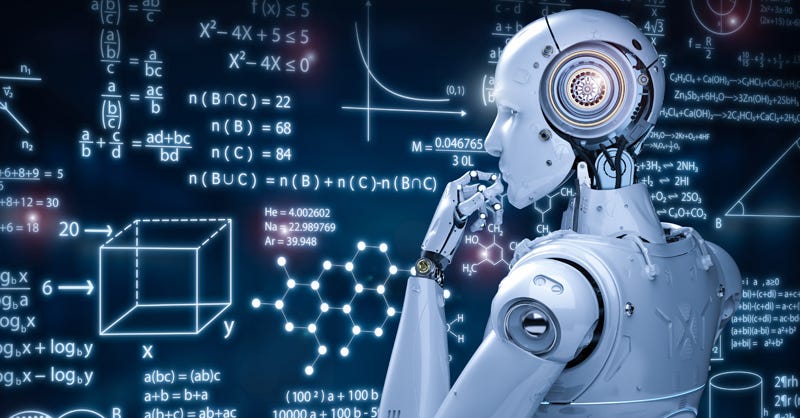All Categories
Featured
Table of Contents
- – The Greatest Guide To New Course: Genai For So...
- – Machine Learning Crash Course For Beginners Ca...
- – How Long Does It Take To Learn “Machine Learn...
- – The Main Principles Of Machine Learning Devel...
- – Should I Learn Data Science As A Software En...
- – The Main Principles Of Aws Certified Machine...
- – Not known Details About Machine Learning Boo...
Some individuals assume that that's unfaithful. Well, that's my whole career. If someone else did it, I'm mosting likely to utilize what that individual did. The lesson is putting that aside. I'm compeling myself to think via the feasible remedies. It's even more concerning taking in the web content and trying to apply those ideas and much less about locating a library that does the job or finding someone else that coded it.
Dig a little bit deeper in the mathematics at the beginning, just so I can build that foundation. Santiago: Finally, lesson number 7. I do not think that you have to recognize the nuts and bolts of every algorithm prior to you utilize it.
I've been making use of semantic networks for the longest time. I do have a feeling of how the gradient descent works. I can not describe it to you today. I would have to go and examine back to in fact get a better intuition. That does not mean that I can not solve points making use of neural networks? (29:05) Santiago: Trying to require people to think "Well, you're not mosting likely to succeed unless you can describe every detail of how this functions." It goes back to our arranging example I think that's simply bullshit recommendations.
As a designer, I've dealt with numerous, several systems and I have actually used many, several points that I do not understand the nuts and bolts of how it works, although I understand the impact that they have. That's the last lesson on that particular thread. Alexey: The funny thing is when I think of all these collections like Scikit-Learn the formulas they use inside to apply, for instance, logistic regression or another thing, are not the like the algorithms we research in artificial intelligence courses.
The Greatest Guide To New Course: Genai For Software Developers
Also if we tried to learn to obtain all these essentials of machine knowing, at the end, the formulas that these collections make use of are different. Santiago: Yeah, definitely. I think we require a great deal much more materialism in the sector.

I normally talk to those that desire to work in the market that desire to have their impact there. I do not dare to talk regarding that due to the fact that I do not recognize.
Right there outside, in the market, materialism goes a long method for certain. Santiago: There you go, yeah. Alexey: It is a good inspirational speech.
Machine Learning Crash Course For Beginners Can Be Fun For Anyone
One of the important things I wished to ask you. I am taking a note to discuss progressing at coding. But first, allow's cover a number of things. (32:50) Alexey: Allow's begin with core tools and structures that you require to find out to actually change. Allow's say I am a software engineer.
I understand Java. I recognize SQL. I understand just how to utilize Git. I recognize Bash. Maybe I understand Docker. All these points. And I find out about equipment understanding, it feels like a great thing. What are the core devices and structures? Yes, I enjoyed this video clip and I obtain encouraged that I don't need to get deep into mathematics.
What are the core tools and structures that I require to learn to do this? (33:10) Santiago: Yeah, absolutely. Wonderful inquiry. I believe, leading, you need to begin finding out a bit of Python. Because you currently know Java, I do not believe it's mosting likely to be a huge transition for you.
Not because Python is the exact same as Java, but in a week, you're gon na obtain a great deal of the distinctions there. Santiago: After that you obtain certain core tools that are going to be used throughout your entire occupation.
How Long Does It Take To Learn “Machine Learning” From A ... Things To Know Before You Buy
That's a library on Pandas for information adjustment. And Matplotlib and Seaborn and Plotly. Those three, or one of those three, for charting and displaying graphics. You get SciKit Learn for the collection of device understanding formulas. Those are devices that you're mosting likely to need to be making use of. I do not recommend simply going and discovering them unexpectedly.
We can speak about specific training courses later. Take one of those programs that are mosting likely to begin introducing you to some issues and to some core concepts of equipment learning. Santiago: There is a program in Kaggle which is an introduction. I don't remember the name, but if you most likely to Kaggle, they have tutorials there completely free.
What's good about it is that the only requirement for you is to know Python. They're mosting likely to provide a problem and tell you just how to utilize decision trees to solve that particular trouble. I think that process is incredibly effective, since you go from no equipment finding out history, to understanding what the problem is and why you can not resolve it with what you understand today, which is straight software engineering practices.
The Main Principles Of Machine Learning Developer
On the various other hand, ML engineers specialize in building and releasing artificial intelligence models. They focus on training versions with data to make predictions or automate jobs. While there is overlap, AI designers deal with more diverse AI applications, while ML engineers have a narrower concentrate on artificial intelligence algorithms and their useful execution.

Artificial intelligence designers concentrate on establishing and deploying machine understanding designs right into manufacturing systems. They function on engineering, guaranteeing models are scalable, reliable, and incorporated right into applications. On the other hand, information scientists have a more comprehensive function that consists of information collection, cleaning, expedition, and structure versions. They are typically in charge of removing insights and making data-driven decisions.
As companies increasingly take on AI and artificial intelligence technologies, the demand for experienced professionals expands. Artificial intelligence engineers service innovative tasks, add to technology, and have affordable incomes. Success in this field calls for continual knowing and maintaining up with developing modern technologies and techniques. Artificial intelligence duties are normally well-paid, with the possibility for high gaining potential.
ML is essentially different from typical software application advancement as it concentrates on teaching computer systems to learn from data, as opposed to shows explicit guidelines that are implemented methodically. Unpredictability of outcomes: You are possibly utilized to creating code with predictable outcomes, whether your feature runs when or a thousand times. In ML, nevertheless, the end results are less certain.

Pre-training and fine-tuning: Just how these models are trained on large datasets and then fine-tuned for particular jobs. Applications of LLMs: Such as text generation, belief evaluation and details search and retrieval.
Should I Learn Data Science As A Software Engineer? Can Be Fun For Everyone
The capability to manage codebases, combine adjustments, and resolve conflicts is equally as essential in ML growth as it remains in conventional software projects. The abilities established in debugging and screening software application applications are extremely transferable. While the context might transform from debugging application logic to recognizing issues in data handling or version training the underlying principles of organized examination, hypothesis screening, and iterative improvement coincide.
Maker understanding, at its core, is heavily dependent on stats and likelihood theory. These are crucial for recognizing exactly how algorithms learn from information, make forecasts, and evaluate their performance.
For those thinking about LLMs, an extensive understanding of deep discovering architectures is valuable. This consists of not only the auto mechanics of neural networks however likewise the style of certain versions for different usage cases, like CNNs (Convolutional Neural Networks) for image handling and RNNs (Persistent Neural Networks) and transformers for consecutive information and natural language handling.
You ought to be conscious of these issues and learn techniques for identifying, reducing, and interacting regarding predisposition in ML versions. This includes the prospective impact of automated decisions and the moral effects. Lots of versions, particularly LLMs, require considerable computational resources that are often given by cloud platforms like AWS, Google Cloud, and Azure.
Building these abilities will not only help with an effective transition right into ML yet also guarantee that developers can add efficiently and properly to the innovation of this dynamic area. Concept is vital, yet absolutely nothing beats hands-on experience. Beginning servicing tasks that allow you to apply what you've found out in a useful context.
Take part in competitors: Join platforms like Kaggle to take part in NLP competitors. Construct your projects: Beginning with basic applications, such as a chatbot or a text summarization tool, and progressively increase intricacy. The field of ML and LLMs is rapidly advancing, with brand-new developments and technologies arising regularly. Staying upgraded with the most up to date research study and patterns is important.
The Main Principles Of Aws Certified Machine Learning Engineer – Associate
Contribute to open-source tasks or compose blog messages regarding your learning trip and projects. As you gain know-how, start looking for possibilities to include ML and LLMs right into your job, or look for brand-new functions focused on these innovations.

Vectors, matrices, and their role in ML algorithms. Terms like design, dataset, features, tags, training, reasoning, and validation. Data collection, preprocessing techniques, design training, assessment processes, and implementation factors to consider.
Decision Trees and Random Woodlands: Instinctive and interpretable models. Matching problem types with ideal designs. Feedforward Networks, Convolutional Neural Networks (CNNs), Frequent Neural Networks (RNNs).
Continual Integration/Continuous Deployment (CI/CD) for ML process. Model tracking, versioning, and efficiency monitoring. Finding and resolving changes in design performance over time.
Not known Details About Machine Learning Bootcamp: Build An Ml Portfolio

Program OverviewMachine understanding is the future for the future generation of software application experts. This training course works as an overview to artificial intelligence for software application designers. You'll be presented to 3 of one of the most relevant elements of the AI/ML discipline; overseen learning, neural networks, and deep knowing. You'll realize the distinctions in between typical programs and maker learning by hands-on growth in supervised understanding prior to building out complicated dispersed applications with semantic networks.
This program works as a guide to maker lear ... Program Extra.
Table of Contents
- – The Greatest Guide To New Course: Genai For So...
- – Machine Learning Crash Course For Beginners Ca...
- – How Long Does It Take To Learn “Machine Learn...
- – The Main Principles Of Machine Learning Devel...
- – Should I Learn Data Science As A Software En...
- – The Main Principles Of Aws Certified Machine...
- – Not known Details About Machine Learning Boo...
Latest Posts
Back-end Engineering Interview Guide – What To Expect
Netflix Software Engineer Hiring Process – Interview Prep Tips
How To Create A Study Plan For A Software Engineering Technical Interview
More
Latest Posts
Back-end Engineering Interview Guide – What To Expect
Netflix Software Engineer Hiring Process – Interview Prep Tips
How To Create A Study Plan For A Software Engineering Technical Interview